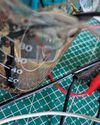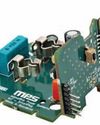How To Convert ChatGPT Into An Advanced Voice Assistant
Electronics For You
|March 2023
ChatGPT-3 needs no introduction. You ask it any question and it replies in a flash. But the answer comes in the form of text. What if you could talk with it, just like you do with any voice assistant like Siri?

It's no secret that ChatGPT has revolutionised the world of AI. Unlike other AI bots, it is able to understand the context of a conversation and respond, and it makes you feel like you are chatting with a human and not a machine.
But as it is still a kind of chatbot, you need to type a question and you get the answer in the form of text. That's not as exciting as talking to a bot.
This thought gave me the idea of programming ChatGPT so that it could be used as a voice assistant called VoiceGPT. I began by using natural language processing (NLP) to recognise the voice, and then transferring the recognised voice to the ChatGPT engine as a query using the API. After getting an intelligent reply from ChatGPT, I again used NLP to convert it into a human voice.
I needed a good NLP tool for this and OpenAI itself provides one, that is, Whisper. But due to limited time and space, I ended up using Google Natural Language API.
A step-by-step guide to making VoiceGPT
We need to begin by combining the NLP for the ttX service with ChatGPT. For this, we need a machine to run the open API, transfer the query gathered from NLP, and reprocess the answer given by ChatGPT into a human voice using NLP.

You can use any laptop, but I chose the Raspberry Pi to run all this. For capturing the voice for recognition, I attached the voice bonnet; a USB microphone can also be used with Raspberry Pi. However, if you are using a laptop to run the VoiceGPT code, there is no need for a USB microphone; you can use the laptop's inbuilt microphone.
This story is from the March 2023 edition of Electronics For You.
Subscribe to Magzter GOLD to access thousands of curated premium stories, and 10,000+ magazines and newspapers.
Already a subscriber? Sign In
MORE STORIES FROM Electronics For You

Electronics For You
Tech Majors Are Racing TOWARDS NET-ZERO - What About You?
Apple, Microsoft, Amazon, Google, Infosys, Wipro—global and Indian firms are heading closer to achieving net-zero emissions, a mandate to combat climate change. Here is what you need to know to start your journey...
12 mins
December 2025

Electronics For You
Miniature IoT WATER TDS And LEVEL MONITOR Cum CONTROLLER
For setups that rely on stored water, clear awareness of tank level and water quality is essential.
3 mins
December 2025

Electronics For You
The Impact Of GENERATIVE AI On The Future Of AUTOMOTIVE AND EVs
Autonomous vehicles, connected ecosystems, and smart factories are only the beginning. Generative Al is pushing the auto industry beyond predictions into a bold era of creativity-from EV design to real-time diagnostics and showroom automation. Here is how GenAl is reshaping innovation across the automotive value chain.
8 mins
December 2025

Electronics For You
How AI Tools Are Making SOFTWARE DEVELOPMENT BETTER
AI is reshaping how we code, debug, and collaborate. From Copilot to automation, it is changing software development in ways worth exploring.
3 mins
December 2025
Electronics For You
How AI Tools Are Making SOFTWARE DEVELOPMENT BETTER
AI is reshaping how we code, debug, and collaborate. From Copilot to automation, it is changing software development in ways worth exploring.
3 mins
December 2025

Electronics For You
5 Interesting Reference Designs FOR SMART HOMES
Smart home devices are transforming the way people interact with their appliances. They make homes more convenient, secure, and energy-efficient. From smart plugs and energy monitors to smart locks and thermostats, reference designs help design engineers create connected products that are easy to use, consume less power, and are reliable. These designs allow you to control devices remotely, track energy use, extend battery life, and automate routines. They provide practical solutions for upgrading homes and small commercial spaces without major modifications.
3 mins
December 2025

Electronics For You
Fancy USB LED VASE
This USB LED vase is a simple yet elegant device that fuses art with electronics to create a decorative lighting display. Powered directly from a standard USB port, it uses readily available components such as MOSFETs, resistors, capacitors, and LEDs to produce a striking, dynamic sequence of lights.
3 mins
December 2025

Electronics For You
"WHAT OTHERS SELL IN FOUR BOXES WE BUILT IN ONE"
Years of custom field work are shaping a product line with its own cloud, its own hardware, and a market that is now beginning to recognise its value.
8 mins
December 2025

Electronics For You
BUILD LARGE LANGUAGE MODELS
Large language models are machine learning models designed for a range of language-related tasks such as text generation and translation. Here’s how open source software can help you build your own large language model.
6 mins
December 2025

Electronics For You
Rare Earth Or Rare Ingenuity? India Remains Between The Two
With China firmly controlling rare earth exports, India confronts a critical moment in its technological trajectory.
8 mins
December 2025
Translate
Change font size

